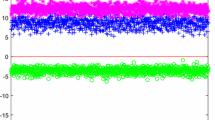Abstract
The quantum max-flow min-cut conjecture relates the rank of a tensor network to the minimum cut in the case that all tensors in the network are identical in Calegari et al. (J Am Math Soc 23(1):107–188, 2010). This conjecture was shown to be false in Cui et al. (J Math Phys 57:062206, 2016) by an explicit counter-example. Here, we show that the conjecture is almost true, in that the ratio of the quantum max-flow to the quantum min-cut converges to 1 as the dimension N of the degrees of freedom on the edges of the network tends to infinity. The proof is based on estimating moments of the singular values of the network. We introduce a generalization of “rainbow diagrams” to tensor networks to estimate the dominant diagrams. A direct comparison of second and fourth moments lower bounds the ratio of the quantum max-flow to the quantum min-cut by a constant. To show the tighter bound that the ratio tends to 1, we consider higher moments. In addition, we show that the limiting moments as N → ∞ agree with that in a different ensemble where tensors in the network are chosen independently; this is used to show that the distributions of singular values in the two different ensembles weakly converge to the same limiting distribution. We present also a numerical study of one particular tensor network, which shows a surprising dependence of the rank deficit on N mod 4 and suggests further conjecture on the limiting behavior of the rank.
Similar content being viewed by others
References
Calegari D., Freedman M., Walker K.: Positivity of the universal pairing in 3 dimensions. J. Am. Math. Soc. 23(1), 107–188 (2010)
Cui, S.X., Freedman, M.H., Sattath, O., Stong, R., Minton, G.: Quantum max-flow/min-cut. J. Math. Phys. 57, 062206 (2016). arXiv:1508.04644
Isserlis L.: On a formula for the product-moment coefficient of any order of a normal frequency distribution in any number of variables. Biometrika 12, 134–139 (1918)
Wick G.C.: The evaluation of the collision matrix. Phys. Rev. 80, 268–272 (1950)
Collins, B., Nechita, I.: Random matrix techniques in quantum information theory. J. Math. Phys. 57, 015215 (2016). arXiv:1509.04689
Zee A.: Quantum Field Theory in a Nutshell, Second Edition, pp. 396–400. Princeton University Press Princeton, NJ (2010)
Feinberg J.: Non-Hermitean Random Matrix Theory: summation of Planar Diagrams, the Single-Ring” Theorem and the Disk-Annulus Phase Transition. J. Phys. A 39, 10029 (2006)
Ambainis A., Harrow A.W., Hastings M.B.: Random tensor theory: extending random matrix theory to random product states. Commun. Math. Phys. 310, 25 (2012)
Voiculescu, D.: Free probability theory: random matrices and von Neumann algebras. In: Proceedings of the International Congress of Mathematicians, Vol. 1, 2, pp. 227–241. (Zurich, 1994). Birkhuser, Basel (1995)
Shuryak E.V., Verbaarschot J.J.M.: Random matrix theory and spectral sum rules for the Dirac operator in QCD. Nucl. Phys. A 560, 306 (1993)
Verbaarschot J.J.M.: Spectrum of the QCD Dirac operator and chiral random matrix theory. Phys. Rev. Lett. 72, 2531 (1994)
Verbaarschot J.J.M.: Spectral sum rules and Selberg’s integral formula. Phys. Lett. B 329, 351 (1994)
Brezin E., Itzykson C., Parisi G., Zuber J.B.: Planar diagrams. Commun. Math. Phys. 59, 35 (1978)
Elias P., Feinstein A., Shannon C.E.: A note on the maximum flow through a network. Inf. Theory IRE Trans. 2(4), 117–119 (1956)
Ford L.R., Fulkerson D.R.: Maximal flow through a network. Can. J. Math. 8(3), 399–404 (1956)
Author information
Authors and Affiliations
Corresponding author
Additional information
Communicated by L. Erdös
Rights and permissions
About this article
Cite this article
Hastings, M.B. The Asymptotics of Quantum Max-Flow Min-Cut. Commun. Math. Phys. 351, 387–418 (2017). https://doi.org/10.1007/s00220-016-2791-8
Received:
Accepted:
Published:
Issue Date:
DOI: https://doi.org/10.1007/s00220-016-2791-8



